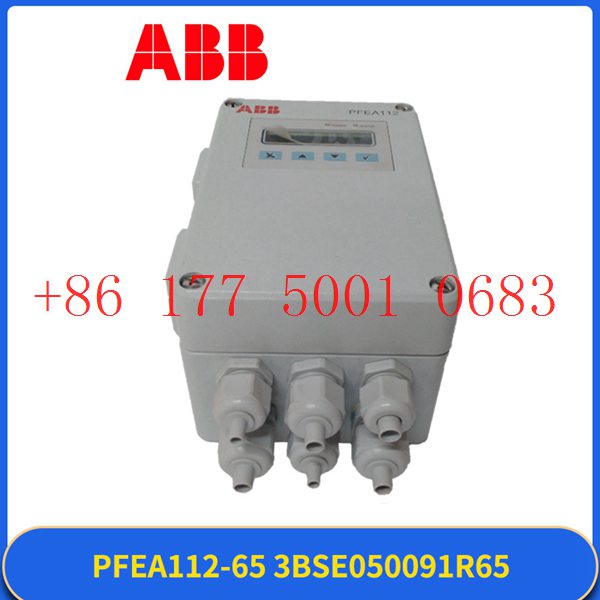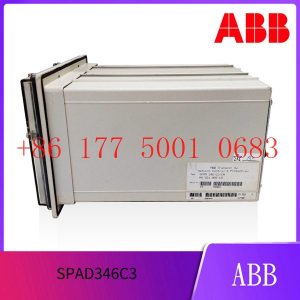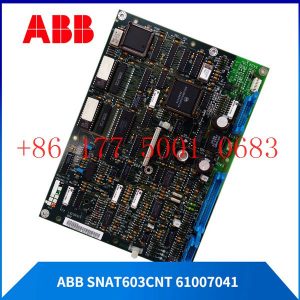Description
PM665 3BDS005799R1 Модуль ввода / вывода ABB
Implementation of communication between ABC industrial robot and PLC based on DeviceNet fieldbus technology
introduction
In modern production systems, industrial robots and PLCs need to communicate and collaborate to complete production tasks. That is, the
industrial robots output signals to the PLC, allowing the PLC to control related equipment to drive the robot”s front-end tools. This article
mainly analyzes the communication problems between ABB industrial robots and PLC based on DeviceNet fieldbus technology.
DeviceNet is a common network communication method in the field of automation. ABB industrial robots establish a network to communicate with
Siemens PLC based on the DeviceNet network.
1Configure DSQC652
There are mainly 5 types of standard I/0 boards commonly used in ABB industrial robots [2]. Except for the different addresses assigned to
them during setup, their configuration methods are basically the same. This article mainly analyzes the ABB standard I/0 board DS0C652, which
mainly builds communication modules based on the DeviceNet network. The DS0C652 board has a distributed I/O module with 16 digital input and 16
digital output interfaces. The board is installed in the ABB industrial robot control cabinet. First, define the specific operation steps of the DS0C652 board,
enter the teach pendant control panel, then enter the configuration menu (Figure 1), select the DeviceNetDevice menu, and add a template to enter Figure 2.
ABB standard I/0 board is hung on the DeviceNet
network, so the address of the module in the network must be set. The jumpers 6 to 12 of terminal x5 are used to determine the address of the module.
The available address range is 10 to 63. Modify the parameters in the template parameters to complete the DS0C652 board settings. Click the drop-down
menu to select the “Use value from template” row, select
“DS0C65224VDCI/0Device”, and then the parameters that need to be set include the address of the I/0 board in the bus.
Figure 1 Configuring DSQC652
2Configure signals and parameters
After completing the DS0C652 board setting, the I/0 signal setting will be performed. Setting the I/0 signal is the basis for establishing communication with
the PLC. The PLC communicates and transmits data with the ABB industrial robot through the I/0 signal and the DS0C652 board. As shown in Figure 3, in the
signal configuration interface, there are many default I/0 points after the system is established. Modification is not allowed. Click “Add” to add signals. When setting
input and output signals, their address range is 0~15. First, enter the signal menu in the configuration options to set the input and output types, and modify the corresponding parameters.
After completing the settings, the computer prompts that you need to restart the settings. If there are multiple signals that need to be defined and the waiting time
is long after restarting multiple times, you can click “Cancel” and wait for all signals to be defined before clicking the “Yes” button to restart. After the signal settings are
completed, click to select “Input and Output” in the ABB menu to check whether all signals have been set.
Figure 2 Configure DSQC652 parameters
Figure 3 Signal parameter settings
During the signal establishment process, attention should be paid to the DSoC652 port and PLC port addresses used, and the corresponding address table should be
established, as shown in Table 1. The robot interacts with the PLC through I/O signals. During the setting process, there must be no errors in the port and address number
of the PLC connected to the DSoC652. If the address is set incorrectly, the communication between the robot and the PLC will not work properly.
The entire robot teaching pendant setting process is shown in Figure 4.
1783-BMS10CA managed Ethernet switch
VE4003S2B6 Analog input card
IC200UDR005 28-point mini PLC module
IC754VSI12CTD-EG Operation panel
VE4033S2B1 Redundant analog input card
8C-PDILA1 HONEYWELL control system switch module
NDCU-21C drive control unit 42000652 ABB
IC695ALG808 Isolates the analog output module
PLX31-EIP-MBS Modbus serial communication gateway
IC695ALG508 Isolates the RTD input module
PCIE-6351 Multifunctional I/O device
IC694MDL930 Relay output module
1756-L73XT/B ControlLogix-XT controller
DX61B0075-5A3-4-00 SEW servo drive
DS200IIBDG1AGA insulated gate bipolar transistor
E69F-TI2-JS current-pneumatic converter
VMIVME-4512 Analog I/O board
MC4/11/10/400 ELAU Motion controller
61866-15pt High performance industrial display
MTL5553 MTL Instrument isolator/Power supply
MTL838C MTL instrument analog transmitter
810-099175-011 LAM Interface board module
DSQC346G 3HAB8101-706B drive unit
5PC810. SX05-00 APC810 system unit
XV 430-12TSB-1-10 EATON 12.1″, TFT color
XV440-10TVB-X-13-1 EATON 10.4 “, TFT color
XV 430-10TVB-1-10 EATON 10.4 inches
XV442-57CQB-X-13-1 ESTON 5.7 inches
XV 432-57CQB-1-10 ESTON 5.7-inch touch screen
XV-440-12TVB-1-50 EATON
XV 440-12TSB-1-10 ESTON Touch panel
XV-440-12TVB-1-50 EATON Man-machine interface
XV 440-12TSB-X-13-1 ESTON 12.1″, TFT Color, i/r, Ethernet, USB, RS232, CANopen
XV442-57CQB-1-10 EATON 5.7 inch, Color, i/r, Ethernet, USB, RS232, CANopen
VE3008 CE3008 KJ2005X1-MQ1 12P6381X042 MQ Controller
05074-A-0122 05704-A-0121 05704-A-0131 honeywell Quad Relay Interface Card
136294-01 BENTLY 3500/62 I/O Module
P0926PA FOXBORO FBM224, FBM230, and FBM231 terminals
VBX01TA ABB Bus Extender
F3430 HIMA Input/output module
P0916FK FOXBORO cable
140471-01 3500/42M I/O Module
F3430 HIMA Relay module F 3430
3500/91-01-01(161204-01+161216-01)bently Communication Gateway Module
LENZE EPL10200-W includes EPZ-10203 CANPT010W3E
UNS0119A-Z,V1 3BHE030579R0001 Automatic voltage regulator
UNITROL 1020 3BHE030579R0003 Indirect Excitation System
UNS0119A-Z,V1 3BHE030579R0001 Automatic voltage regulator
LAIB V3.0_A00 034STN1-01-300-RS







Reviews
There are no reviews yet.